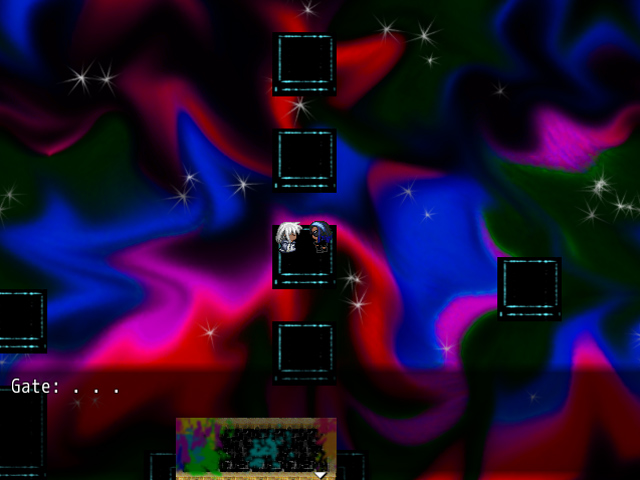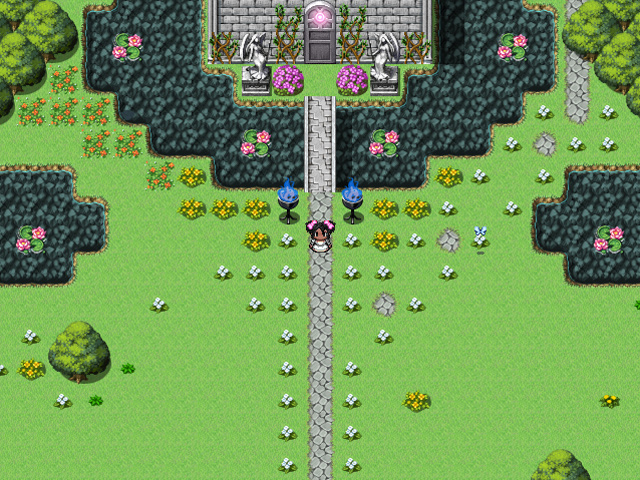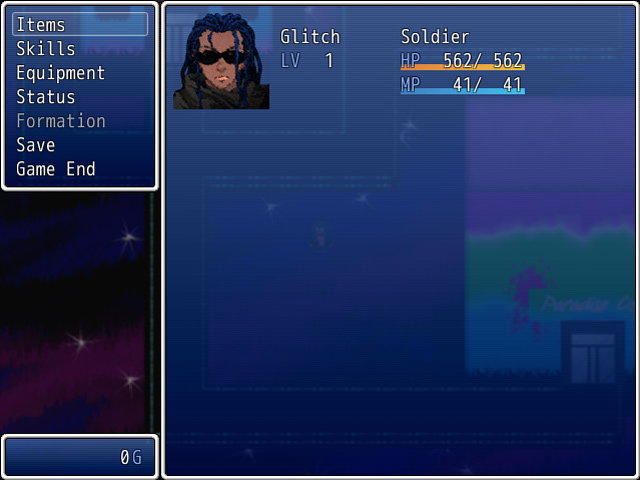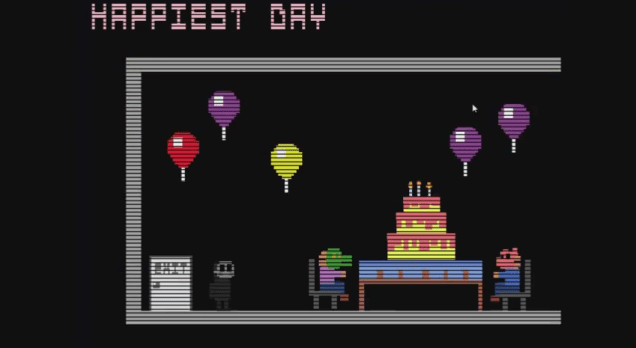Sometimes a series of lines curve and become a circle. Then that same line curves outward and makes the circle into a spiral. And then the line, that particular line, continues around the spiral and creates the second level of the spiral, emulates three dimensions, and breaks down into its essential numerical binary parts.
So after you imagine Gaming Pixie’s circle of Twine games leading to another string of personal dimensions, think of the second layer of her spiral of game making as a circle of glowing ones and zeroes in the form of Raziel.
For me the main challenge in writing about Raziel is that much of it is already documented by Gaming Pixie herself on her Games site. In a series of relatively short entries you will find that she began Raziel as a Twine for a Cyberpunk Game Jam: the premise of which expanding over time to include a few more details and various changes in mechanics as it became a short 16-bit game made on RPG Maker.
To be honest, even though I’d played the Twine game some time ago, and I was following the developer posts on Gaming Pixie’s Blog, I actually didn’t know what to expect from Raziel.
I’ll tell you what I did find though. Imagine a combination of The Matrix with its artificial intelligences and hacker themes, Inception with its levels of intersecting reality and memory, Christine Love’s *AI games with their background of gender, sexuality, and treatment of AI as individual entities, and Kan Gao’s To the Moon with its heartfelt use of virtual capsules and subversion of a single instance of combat. Raziel is reminiscent of these films and games, but it is more.
On the surface, Raziel is a cyberpunk game about a hacker named Glitch who seeks to kill a fallen angel: someone who must leave the Real World and enter the virtual Otherworld in order to fulfill this task.
The Real World itself in the game is a grey and closed off space: with very few places to go or see. As per some cyberpunk settings, it is almost a closed linear circuit of grim reality: to the point where the extra rooms and levels in the protagonist’s apartment building and the virtual chambers in the material version of Raziel’s Tower are almost superfluous. It’s specifically designed to be a world where you don’t want to spend much time.
Basically you are navigating a cyberpunk world that interfaces from the Real World into Otherworld and, eventually, a series of inaccessible and non-human user junk code in the form of Etherworld. Otherworld and Etherworld, one decked in bright neon colours and the latter in light-screen fragments and binary are circular worlds: the former possessing few barriers and the latter possessing random ones.
Getting into and out of Otherworld, which is essentially an over-world map to other places is easy, but traveling into and interacting with, and getting out of, Etherworld is much more difficult: a series of different levels that — appropriately — intermix an over-world map layout with specific levels depending on what you access.
But this is where our overview ends: because if we journey any further into Otherworld’s circle of eternity, or Etherworld’s realm of code we are inevitably going to find a class of virtual sprite known as Spoilers.
So now that we are here, past the point of safety, I am going to give you the same choice that Gaming Pixie gives all of her players.
If you don’t want to use the Augment, read no further unless you’d like to hack further and remote-view said spoilers. However, if you’ve agreed to take the Augment then prepare yourself for exploration.
The warning above is somewhat misleading, when all things are considered. The option to use Augments, illegal and dangerous cybernetic enhancements that were both more prevalent and allowed you to access Otherworld in the Twine, exist only in the RPG as a plot device: something that gains you, through the character of Glitch, the initial notice of Raziel himself. The rest of what happens after that is entirely up to you. The game has an edgy attitude like that.
As such, there are quite a few differences between the Twine and RPG versions of Raziel. While the Twine has only the Real World and Otherworld, Gaming Pixie added Etherworld to the RPG: a place where the users’ intentions from reality intermix with junk data. In addition, only AI can generally access Etherworld. The best way to look at Etherworld is to imagine looking at the real workings of a living body dissected right in front of you, except you’re interacting with its subconscious mind that’s also laid bare. It is disturbing and it is meant to be.
Whereas in the Twine Augments were the only way you could “unofficially” access Otherworld, in the Raziel RPG Augments are used to heighten sensations in Otherworld: bringing you into a state of Null Space that we never see in the game but which we see quite a few references. People can go mad or die from using either “bad” or, again, illegal Augments. Also, if you look carefully enough you’ll realize just how important Augments have been in Glitch’s decision making. I wish you happy hunting on the latter, by the way, as I totally missed it on my first playthrough.
There are also no AI in the Twine version of this game. In order to create an RPG, Gaming Pixie had to expand on the world she first created but it pays off. First of all, you don’t always know who the AI are. It’s true that there are AI that serve one rudimentary purpose — similar to the Virtual Intelligences of Mass Effect — but there are others who are friendly, standoffish, and even creative in their own rights. Second of all, even the former type of AI is important to the game: in the form of Gates. Gates also don’t exist in the Twine predecessor of this game: essentially they are messengers or avatars of the fallen angel Raziel that actually allow you to access Etherworld as a human user.
But activating these living Gate AIs is not as easy as merely identifying and approaching them. What you really need to do is get hints from your handler, a woman named Maven — about specific interactions that you need to undertake, find where those are situated, and then find the Gates and access them. You will find that Raziel is subversive in that it uses the mode of the 16-bit RPG to explore: accessing an environment that is literally composed of navigating built-in puzzles specifically in the form of interactions with other characters. Everything is connected in Raziel. That is the point.
Even though Gaming Pixie helpfully provides you with a Database of beautifully pixelated sprite profiles and useful information that you gather as you interact with the world it is only through your interactions with the cybernetic aspects of this virtual reality — the humanoid elements in the electronics — that you even get this information, or feel any investment with it beyond your character’s own enigmatic self-interest.
Just like in the Twine version of Raziel, it is your mission as Glitch to destroy Otherworld by killing its living CPU the angel Raziel: and there are implications in doing so. Whereas in the Twine game destroying Otherworld potentially frees human users from the stasis of their own ennui, in ignoring the real world and beginning to get them to face the painful but inevitable task of making their offline lives better, there is a lot more at stake in the RPG. It’s true that many people come to Otherworld for escapism, but there are other programs that exist there as well.
For example, there is Esme: a snow princess who was created to be the friend of a girl who later committed suicide and who now exists to remember her and help other girls. There is an elderly couple that were programmed to function as foster parents: as the only loving guardians a young girl has ever had. And then you have Persephone: an AI who has exceeded her programming, changing her original name of Penelope, and creating artistic programs in her own right. If you destroy Otherworld, you will not only rob some of the human users of their friends and family, but you will basically murder other self-aware beings in the process.
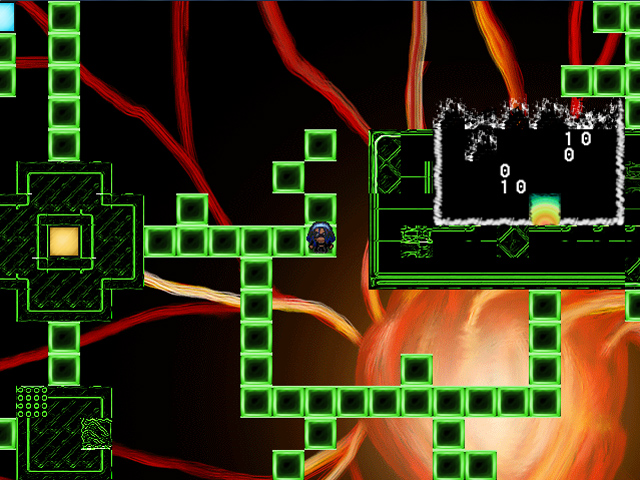
But even then, it’s not as easy as merely stopping. There is Raziel himself to consider. The reason you have to kill Raziel doesn’t change from the Twine to the RPG. Raziel was a human being connected to the Otherworld for over fifty years. His physical form has been hanging between life and death, leaving him in constant agony, as his mind has been used to create and maintain the reality of Otherworld. Essentially, he is the one who gives you the mission to kill him: to end his pain. While you have to directly find him yourself in the Twine, his contact and friend Maven is the one who recruits you, after he finds you in another form, to undertake this act of mercy.
That’s right. The final boss of the game wants you to kill him and even helps you to do so after an awe-inspiring cut scene and a particularly vicious battle. There are no other random battles in Raziel. The other encounters you have are by necessity those that you don’t confront in Etherworld. There is no grinding, or leveling up your character. There is one boss battle: and it is the most difficult challenge you will have in this game, morally and physically.
If you kill Raziel, the Angel of Mysteries in Judeo-Christian theology, you will end his pain but you will destroy Otherworld and every AI in it: robbing its human users of their one joy and connection in contrast to a dull and colourless existence in the Real World. But if you let him live, he will inevitably go insane, crash Otherworld, and take everyone down with him. It’s much like the illusion of alternate paths in Gaming Pixie’s games What’s In a Name? or, fittingly enough, The Choice. In fact, it doesn’t really feel like much of a choice at all, does it?
That is something else both the Twine and RPG versions of this game have in common. In fact, should you choose the “wrong” options, the game will shut itself down much in the way Toby Fox’s Undertale will do when you also choose wrong, or lose.
But here is the interesting part: in contrast to the idea of the illusion of free will, in Raziel it is actually about a lack of choice being the illusion. Even if your choices seem limited, they still exist and if you think about the greater good, you will make the right one. Yet while the Raziel Twine leads to the game “crashing” no matter what you do, choosing the option of the lesser evil, the RPG is more nuanced. The battle with Raziel is inevitable, but how you choose to fight Raziel depends on how you much you explore beforehand, and how much you pay attention.
You can see the influence of Gaming Pixie’s She Who Fights Monsters on the ultimate outcome of the RPG. At the end of Monsters you — as the protagonist of Jenny — encounter a screen where you have to choose between three boxes: love, hate, and indifference. Some of those options will be opened or closed to you depending what karmic choices you undertook in that game: and specifically whether or not you accessed the places where the game’s Memory Crystals are found.
However, in the Raziel RPG it is different. In the cavern that represents Raziel’s virtual prison, there are four other rooms guarded by the Gates with which you’ve interacted to get this far. In it are four coloured Flames that represent different aspects of Raziel’s power and suffering: pain as defense, anger as attack, sadness as magic, and regret as evasion. Whereas accessing Monsters’ boxes or Crystals determines Jenny’s developing personality and future, encountering and defusing the Flames actually de-buffs Raziel’s stats: keeping you from getting curb-stomped in your battle with him.
Trust me: you know that box that comes up before you go into Raziel’s main prison cell asking you if you want to go further and if there is anything else you want to do? For the love of God, listen to that message for what it is: a warning. According to Gaming Pixie, this box wasn’t originally there — she had to add it so that the encounter wouldn’t be completely impossible — and once you go into that cell you will save and not be able to get out again. You will die: many, many times against the power of Raziel.
Yet why is it that despite Raziel’s aid, his manipulations, and his request for death that he fights you with every fiber of his being? Why doesn’t he just give up and let you kill him? Are there safeguards in place that automate him to protect himself? Or is it more than that?

I am going to reveal to you Raziel’s and ultimately the RPG Raziel‘s ultimate secret. The truth is that Raziel doesn’t really want to die. The Otherworld built from Raziel is wondrous, but there has always been something missing from it: some component that the best scientists and technicians could never replicate. Glitch has felt this and other users have no doubt done the same: perhaps even influencing their need to leave the banality of the Real World and use questionable Augments and experience Null Space while they are there. But that’s just it: it is merely existence. And existence does not necessarily equal essence. Existence is not life.
It’s Raziel’s sense of self-preservation that makes him fight you. It’s your sense of wanting to live that makes you, as Glitch, want to fight back and finish the deed. It is that moment on the edge of death, of contemplating oblivion, that the will to live is arguably the strongest impulse any living being can ever possess. And this is where the two Raziel games diverge with extreme prejudice: the Twine game being a grim lesson in the lesser of two evils and the RPG — Raziel itself — becoming a story about connecting with others, learning to feel the needs of others above your own, helping them shed the pain of their old and cumbersome attachments, and allowing things to be renewed: allowing the angel to be reborn.
It is a redemptive ending as Raziel leaves his physical body behind and becomes a powerful AI that flushes the will to live throughout the entire system of Otherworld. It’s as though Raziel played Gaming Pixie’s The Choice himself — a game about suicide — and realized the most positive and powerful choice is to live. But it is not just Raziel who makes this decision.
If you consult Gaming Pixie’s Blog entries on Raziel, you’ll realize that she wanted to incorporate the karmic system that is popular in her Eden, Shadow of a Soul, and She Who Fights Monsters games as well as many other independent ones of late, but she decided against it and took another approach. While Raziel is about the angelic CPU of Otherworld, it is also about Glitch.
Glitch becomes more than an optional name in a Twine game. In another loop between her video game creations, Gaming Pixie takes you out of the second-persona of “you,” and places you behind Glitch’s first-person “I” perspective. Glitch follows your commands: within reason. This game persona mechanic is reminiscent of Christine Love’s don’t take it personally, babe, it just ain’t your story. The hacker is caustic, sarcastic, and sometimes outright impatient. You might want to explore, and Glitch will indulge you until you intrude on someone else’s personal space, go against their wishes, or you waste Glitch’s time. In this sense, Glitch is the narrative of the game. Even Etherworld and one ending of the game where it crashes is a reference to Glitch’s actual name and what it means in a system like a video game.
Yet Glitch is more than this. It’s strange. In Gaming Pixie’s other games, your gender is neutral, default female, or you have a choice between three genders of “him,” “her,” and “they.” In Raziel, however, you only get two genders to choose from. This is a controversial move in a lot of ways: especially when you consider that depending on whether Glitch is male or female, this protagonist will interact with other characters in different ways. Even so, his or her personality is generally the same and is more than just a blank slate silent or unnamed protagonist. And if you look closely, very closely, and double-check all information about Augments in the game you might also find just what might be the motivation behind Glitch wanting to destroy Otherworld.
There is, however, one other element that definitely shines through. Whether you choose to be male or female, Glitch is always going to be a Black bisexual person. Bisexuality is a core theme in many of Gaming Pixie’s games as a legitimate sexual orientation and identity: just as it is for her main characters to generally have a default Black identity. The way this is introduced is just as a given. Everything else in Raziel is utterly fantastic, whereas diversity, bisexuality and indeed the LGBTQIA spectrum is seen as commonplace: especially in a virtual world where you can appear as you want to be.
Even so, it is intriguing how when Glitch is female you get a little more clue as to her mental state as she develops a relationship with Maven, who is a lesbian, whereas the information about Glitch’s past is hinted upon differently when he is male and he tells a gay and newly incarnated Raziel — who becomes his lover — that it has been a while since he has been with a man. But either way, Glitch has his or her own exposure to that life affirming moment where they realize they want to live: and actually move on with a real life past their former self-destructive Augments by the game’s end.
Writing about Raziel is hard. It feels like every time I thought I was making progress, I encountered one of the angel’s Gates, or I had to search for a node to access in a confusing realm of junk data and ideas threatening to diverge from the point, or that each time I was missing the prison chambers that could lessen the stats on my sense of intimidation in writing about the game. Certainly, I began to wish that I could take an Augment just to make sense of it all: just to organize these experiences. But Raziel is about binaries. It’s about the differences and similarities between the Real World and Otherworld, male and female, human and AI, hope and despair, Gaming Pixie’s other games and Raziel, and even the Twine and the RPG version of Raziel.
Essentially, I’ve had to make an Etherworld out of Gaming Pixie’s game: exposing some of its bones and shapes, while giving you hints about its codes and interactions. It’s like weaving behind a curtain while simultaneously painting the scene of the stage. But it’s more than that. If I’m going to refer to Gaming Pixie’s Etherworld, I should mention that it is the heart of Raziel. It is its soul and its very being: and it says something powerful about the human condition.
At the beginning of this article, I mentioned that I had no idea what to make of Raziel but I can safely say that through this short game built from her Twine, Gaming Pixie has more than exceeded my expectations. Her particular voice shines through both her pixels and her text with the strength of empathy. In fact, if there is one flaw in what she’s built it’s that she’d built an entire world that deserves more than just one interactive story.
You can find Raziel, for free, at Gaming Pixie’s Games and I couldn’t recommend it more.





